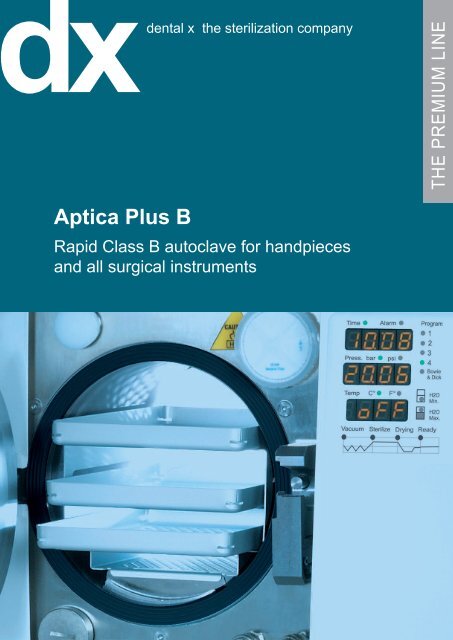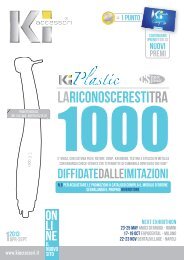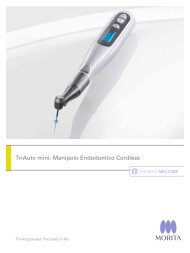Aptica Plus B - Dental2000.It
Aptica Plus B - Dental2000.It
Aptica Plus B - Dental2000.It
You also want an ePaper? Increase the reach of your titles
YUMPU automatically turns print PDFs into web optimized ePapers that Google loves.
xdental x the sterilization company<br />
THE PREMIUM LINE<br />
<strong>Aptica</strong> <strong>Plus</strong> B<br />
Rapid Class B autoclave for handpieces<br />
and all surgical instruments
<strong>Aptica</strong> <strong>Plus</strong> B<br />
Rapid class B sterilization for turbines and handpieces<br />
The sterilization of handpieces and turbines<br />
is a delicate operation which, if<br />
not carried out properly, can compromise<br />
the safety of the sterilization process<br />
and performance of the<br />
instruments.<br />
Dynamic instruments are composed of<br />
high-precision micro-mechanisms.<br />
The metals used to make these instruments<br />
may undergo alterations caused<br />
by the temperature, thus it is<br />
particularly important to avoid thermal<br />
stress during the sterilization cycle and<br />
the drying process.<br />
For the sterilization of handpieces and<br />
turbines, the standard EN 13060 requires<br />
the use of class B autoclaves<br />
with fractionated vacuum which ensures<br />
the passage of steam inside hollow<br />
instruments of type A and B (Helix<br />
test).<br />
Most class B autoclaves, however, do<br />
not guarantee a homogeneous temperature,<br />
and the thermal stress to which<br />
the instruments are exposed during<br />
the cycle can cause early deterioration<br />
with a negative impact on the costs<br />
and quality of surgical treatments.<br />
<strong>Aptica</strong> <strong>Plus</strong> B also offers important advantages<br />
over injection systems,<br />
which fail to comply with standard EN<br />
13060 and provide for a universal validation<br />
protocol.<br />
Furthermore, steam injection systems<br />
can only sterilize a few instruments at<br />
a time; they cannot sterilize wrapped<br />
instruments, and they are often more<br />
complicated to connect and install.<br />
<strong>Aptica</strong> <strong>Plus</strong> B ...the professional<br />
choice
Dental X ... excellence in the sterilization sector<br />
Fast<br />
<strong>Aptica</strong> <strong>Plus</strong> B Premium Line can run a<br />
cycle in roughly 12 min (drying included).<br />
The B cycle (helix test) can be<br />
done in less than 18 minutes (drying<br />
included).<br />
High performance<br />
<strong>Aptica</strong> <strong>Plus</strong> B can sterilize 12 wrapped<br />
handpieces or 18 unwrapped ones in<br />
one cycle.<br />
Delicate<br />
As a result of its special heating system,<br />
<strong>Aptica</strong> plus B prevents thermal<br />
stress and allows delicate sterilization<br />
without the risk of damaging or breaking<br />
the handpieces.<br />
Eco sustainability<br />
Despite the fast cycles, <strong>Aptica</strong> <strong>Plus</strong> B<br />
has a very low consumption. The special<br />
heating system enables power<br />
and water savings with obvious cost<br />
and environmental advantages.<br />
Reliability<br />
Due to its consolidated technology and<br />
the use of the same components as<br />
our larger models, <strong>Aptica</strong> plus B is very<br />
reliable even under intensive use.<br />
Flexibility<br />
Although designed for handpieces, <strong>Aptica</strong><br />
<strong>Plus</strong> B can sterilize all type of instruments.<br />
In compliance with the<br />
standard EN 13060, it can operate<br />
both class B and S cycles.<br />
Validation<br />
The sterilization is performed in compliance<br />
with the standard EN 13060,<br />
and the cycles can be easily validated.<br />
Complementary<br />
Generally a large autoclave requires<br />
more time to be loaded and is inconvenient<br />
for the rapid sterilization required<br />
for daily surgical activities. <strong>Aptica</strong><br />
<strong>Plus</strong> B can be considered the natural<br />
complementary autoclave for all modern<br />
cabinets.<br />
Ergonomic<br />
Thanks to its small size, <strong>Aptica</strong> <strong>Plus</strong> B<br />
can be easily located anywhere.<br />
<strong>Aptica</strong> <strong>Plus</strong> B represents the state of<br />
the art in handpiece sterilization.<br />
Take care of your<br />
valuable instruments
<strong>Aptica</strong> <strong>Plus</strong> B: the new standard for handpiece sterilization<br />
<strong>Aptica</strong> <strong>Plus</strong> B is equipped with a sophisticated<br />
process evaluation system to<br />
monitor the saturation of the steam.<br />
The system is based on control of the<br />
temperature-pressure correlation during<br />
the sterilization phase.<br />
Even though process evaluation systems<br />
have become mandatory, there<br />
are still autoclaves available on the<br />
market without them which are therefore<br />
unable to guarantee the sterilization<br />
process.<br />
This function makes <strong>Aptica</strong> <strong>Plus</strong> B capable<br />
of self-control, as if there were 2<br />
control systems inside the autoclave.
Dental X ... the sterilization company<br />
Small ...but great!<br />
Small nickel-plated copper chamber<br />
The high thermal conduction of copper<br />
(25 times higher than steel) and small<br />
chamber size has made it possible to<br />
achieve ultra-rapid cycles.<br />
This autoclave has been purposely designed<br />
with a small size in order to<br />
meet the sterilization needs of a practice<br />
with a high turnover of instruments.<br />
The 4.5-liter chamber allows sterilization<br />
of up to 12 wrapped turbines (4<br />
per tray) or 18 unwrapped turbines as<br />
well as all the surgical instruments.<br />
Despite the small dimensions, the sterilization<br />
capacity is equal to that of a<br />
large autoclave. Instead of waiting to<br />
collect all the instruments, the cycle<br />
can be carried out between one patient<br />
and another.<br />
<strong>Aptica</strong> <strong>Plus</strong> B can also be considered<br />
as a complementary autoclave for resolving<br />
the handpiece sterilization problem<br />
and acting as a backup in case<br />
of failure of the “large” autoclave.<br />
Dental X ...the choice of<br />
professionals.<br />
Temperature variations can have negative<br />
effects on the micro-mechanisms<br />
and lead to their breakdown.<br />
Complete automatism<br />
The autoclave is equipped with 2 class<br />
B automatic programs, one class S<br />
program and 5 programs for special<br />
needs.<br />
With the autoclave’s self-control system,<br />
the operator is not required to be<br />
present during the cycle and the cycle<br />
can even be carried out during the<br />
night.<br />
The machine regularly signals the expiration<br />
of service requirements and<br />
any validations.<br />
Although the use of <strong>Aptica</strong> <strong>Plus</strong> B is<br />
simple and intuitive, menus are available<br />
which allow the operator to learn<br />
more about the diagnostics, carry out<br />
calibrations and set new sterilization<br />
parameters in order to adapt the machine<br />
to new needs or new standards.<br />
An advanced self-diagnosis and trouble-shooting<br />
system makes problem<br />
solving simpler and faster with significant<br />
cost savings.<br />
The autoclave is set up to carry out the<br />
Helix test, the Bowie & Dick test and<br />
the vacuum test.
<strong>Aptica</strong> <strong>Plus</strong> B<br />
...the most advanced device for handpiece sterilization<br />
Adaptive Heat<br />
This is the innovative heating system<br />
designed by Dental X to accelerate the<br />
sterilization cycles and reduce consumption.<br />
This exclusive system eliminates thermal<br />
stress and allows safer sterilization<br />
of the turbines and handpieces<br />
without the risk of early deterioration.<br />
The Adaptive Heat heating system<br />
takes advantage of the conductive<br />
properties of the copper used to build<br />
the chamber. Thanks to the high conduction<br />
of the copper, a new-generation<br />
active heating element system<br />
has been designed which heats the<br />
chamber in a differentiated manner<br />
based on the thermal flow of the steam<br />
and the different phases of the cycle.<br />
This allows the elimination of thermal<br />
stress and acceleration of the heating<br />
phases without resorting to electronic<br />
devices, steam injection or compromising<br />
the reliability of the heating elements<br />
themselves.<br />
The copper - multiple heating element<br />
combination enables faster cycles with<br />
homogenous distribution of the steam<br />
while keeping the peak temperatures<br />
of the heating elements and surface<br />
temperatures of the chamber equal to<br />
the sterilization temperature, thus safeguarding<br />
the long-term service life of<br />
the heating elements and the reliability<br />
of the system as a whole.<br />
Active Steam Injection System<br />
This is a new technology that allows<br />
the water to be heated before entering<br />
the chamber using the thermal energy<br />
of the primary heating elements.<br />
Unlike steam generators, the Active<br />
Steam Injection System does not require<br />
additional energy and is definitely<br />
more reliable.<br />
Warm-up System<br />
During the depressurization phase, the<br />
water in the tank is pre-heated by recovering<br />
the thermal energy of the<br />
steam.<br />
This technique achieves faster cycles<br />
without increasing power consumption.<br />
Furthermore the warm up helps<br />
to degas the water and speed up the<br />
vacuum phases.
Dental X ... because not all autoclaves are created equal<br />
Vacuum pump<br />
The air is expelled by a powerful diaphragm<br />
pump which guarantees fast<br />
and quiet expulsion (fractionated vacuum).<br />
Under normal conditions and with regular<br />
servicing, the pump performs<br />
about 10,000 cycles. To improve the<br />
performance and service life of the<br />
pump, a special separator has been<br />
designed which divides the water contained<br />
in the steam from the air.<br />
The vacuum pump has a dual function:<br />
1) It creates the vacuum before sterilization<br />
in order to allow the steam<br />
to penetrate hollow instruments.<br />
2) It creates forced ventilation during<br />
the drying phase to eliminate condensate<br />
residue and dry the bags<br />
faster and more efficiently.<br />
Volumetric doser<br />
The autoclave uses water to generate<br />
steam.<br />
The quantity of water used is very important.<br />
If too little is used, the cycle<br />
may fail due to lack of water; but if too<br />
much is used the cycle slows down<br />
and the times become longer.<br />
The volumetric doser is an exclusive<br />
component that allows to precisely<br />
measure the quantity of water.<br />
Filters<br />
Filters protect the hydraulic circuit inside<br />
the autoclave and help to reduce<br />
malfunctions of solenoid valves and<br />
the pump. The filters can be easily inspected<br />
and changed when necessary.<br />
Traceability allows to trace the entire<br />
sterilization process or the process of<br />
the sterilized instruments.<br />
USB<br />
<strong>Aptica</strong> <strong>Plus</strong> B is equipped with a USB<br />
port to allow archiving of the cycles on<br />
a USB flash drive.<br />
The USB system allows orderly storage<br />
of the sensitive data of the cycle<br />
in a file. The operator can download<br />
the files on the computer periodically<br />
and open them with a normal text program.<br />
This system allows to eliminate paper<br />
and printouts, thus simplifying the entire<br />
process and minimizing error margins.<br />
Printer<br />
For those who prefer to have a paper<br />
report of the cycle, a model with printer<br />
is also available.<br />
The printer allows the operator to automatically<br />
print the cycle report including<br />
records of the various phases and<br />
the final outcome.<br />
Bar code label printer<br />
For those who would like increased<br />
traceability, the autoclave can be connected<br />
to a special adhesive label<br />
printer.<br />
These printers can print adhesive labels<br />
with a bar code and associate<br />
each individual bag to each patient.
Caratteristiche tecniche<br />
<strong>Aptica</strong> <strong>Plus</strong> B<br />
External dimensions<br />
L. 443 x P. 545 x A. 254 mm<br />
Chamber dimensions<br />
Ø 156 x P. 251 mm<br />
Chamber capacity<br />
4,5 lt<br />
Net weight<br />
27 kg<br />
Max power consumption<br />
1.400 W<br />
Average power consumption<br />
600 W<br />
Supply voltage<br />
230 V - 50 Hz<br />
Air expulsion<br />
Vacuum pump<br />
Water recervoirs<br />
N. 2 recevoirs 3,5 lt each<br />
Automatic programs 7<br />
Drying cycle<br />
n<br />
Bowie & Dick test<br />
n<br />
Helix test<br />
n<br />
Vacuum test<br />
n<br />
Automatic switch off - Night cycle<br />
n<br />
Process Evaluation Control<br />
n<br />
Adaptive Heat<br />
n<br />
PC connection for USB Log and PC<br />
n<br />
Printed integrated/external optional<br />
n<br />
Volumetric doser<br />
n<br />
Water quality control<br />
n<br />
Bacterial filter - high filtration<br />
n<br />
Self diagnosis and trouble shooting<br />
n<br />
Cycle counter<br />
n<br />
Average sterilization time*<br />
12 - 20 min<br />
www.dentalx.it<br />
* The cycle time can change depending on load’s type and quantity, the pre-heating, the power voltage and the use and<br />
manteinance conditions.<br />
Programs Parameters Indication<br />
1 STERILIZATION 1 134 °C - 5 min<br />
For every load that could be<br />
submitted to 134 °C (Helix Test)<br />
B<br />
2 STERILIZATION 2 121 °C - 20 min<br />
For every load that could be<br />
submitted to 121 °C (Helix Test)<br />
B<br />
3 FLASH 134 °C - 4 min<br />
Rapid cycle for unwrapped surgical<br />
instruments<br />
S<br />
4 S1 Prion 134 °C - 18 min For Creutzfeld Jacob desease B<br />
S2 Heavy load 134 °C - 5 min For special loads B<br />
S3 Heavy load 121 °C - 20 min For special loads B<br />
S4 BSE Selected by the operator Depends by the selected parameters<br />
Bowie & Dick 134 °C - 3,5 min<br />
Vacuum Test 20 min<br />
Dental X reserves the right to make changes to the specifications illustrated.<br />
3YEARS<br />
WARRANTY<br />
dentalX<br />
0120<br />
Tipo-lito ABALTI G.F. - Creazzo (VI) • Code: GB_<strong>Aptica</strong><strong>Plus</strong>B_201303






